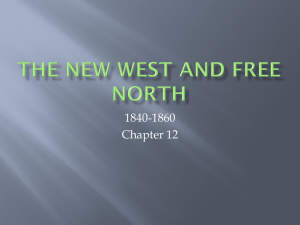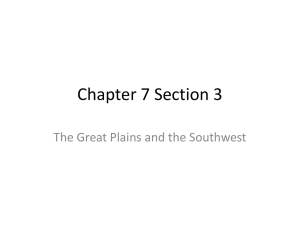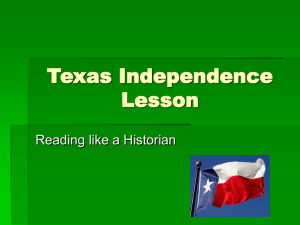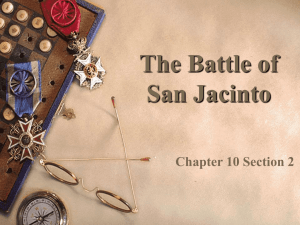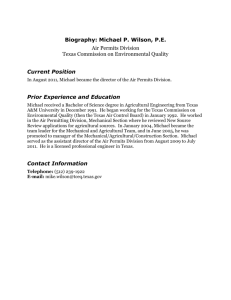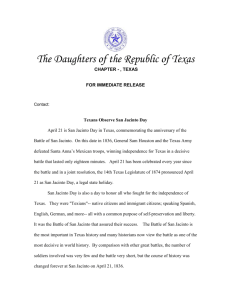File cba 1 questions and answers 2015
advertisement
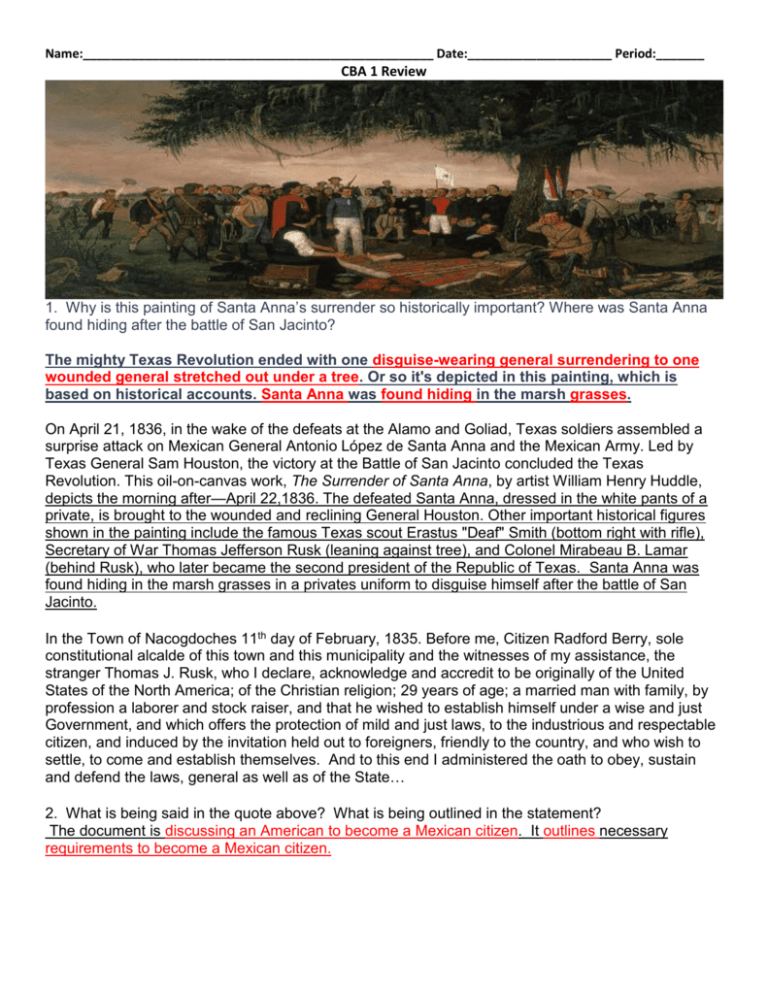
Name:___________________________________________________ Date:_____________________ Period:_______ CBA 1 Review 1. Why is this painting of Santa Anna’s surrender so historically important? Where was Santa Anna found hiding after the battle of San Jacinto? The mighty Texas Revolution ended with one disguise-wearing general surrendering to one wounded general stretched out under a tree. Or so it's depicted in this painting, which is based on historical accounts. Santa Anna was found hiding in the marsh grasses. On April 21, 1836, in the wake of the defeats at the Alamo and Goliad, Texas soldiers assembled a surprise attack on Mexican General Antonio López de Santa Anna and the Mexican Army. Led by Texas General Sam Houston, the victory at the Battle of San Jacinto concluded the Texas Revolution. This oil-on-canvas work, The Surrender of Santa Anna, by artist William Henry Huddle, depicts the morning after—April 22,1836. The defeated Santa Anna, dressed in the white pants of a private, is brought to the wounded and reclining General Houston. Other important historical figures shown in the painting include the famous Texas scout Erastus "Deaf" Smith (bottom right with rifle), Secretary of War Thomas Jefferson Rusk (leaning against tree), and Colonel Mirabeau B. Lamar (behind Rusk), who later became the second president of the Republic of Texas. Santa Anna was found hiding in the marsh grasses in a privates uniform to disguise himself after the battle of San Jacinto. In the Town of Nacogdoches 11th day of February, 1835. Before me, Citizen Radford Berry, sole constitutional alcalde of this town and this municipality and the witnesses of my assistance, the stranger Thomas J. Rusk, who I declare, acknowledge and accredit to be originally of the United States of the North America; of the Christian religion; 29 years of age; a married man with family, by profession a laborer and stock raiser, and that he wished to establish himself under a wise and just Government, and which offers the protection of mild and just laws, to the industrious and respectable citizen, and induced by the invitation held out to foreigners, friendly to the country, and who wish to settle, to come and establish themselves. And to this end I administered the oath to obey, sustain and defend the laws, general as well as of the State… 2. What is being said in the quote above? What is being outlined in the statement? The document is discussing an American to become a Mexican citizen. It outlines necessary requirements to become a Mexican citizen. 3. All of the previous pictures represent energy sources available in Texas. Of the three photos, which one depends on wind and which regions of Texas can they be found working? The wind turbines of the great-plains and north central plains. Not in the Coastal plains because of the lower elevations and less frequent winds. Dear Brother, . . . Houses are very sorry in this country for it is a considerable job to build a cabin. . . owing to the timber being so scarce and plank is out of the question. The people use what they call puncheon which is ash. . saplings split open and laid down for floors. . . . a man can raise as many cattle as he pleases without feeding them at all and can kill fat beeves anytime in the winter. . . . The grass is now green. . . Excerpt form a letter written by C. Baker in 1853. Switzer, David. It’s Our Dallas County. 1954. 4. What does the word plentiful mean? What does the word scarce mean? How can they be applied to the following excerpt? Scares means that an item it is not abundant, very little to go around Plentiful means that an item it is abundant, there are large enough quantities of the item to go around. In the excerpt, wood or timber is scares and grass is plentiful 5. How were the Coahuiltecan and the Karankawa similar and different? Both lived in the Coastal Plains, hunters and gathers, had portable homes. The main difference between them was in their diets, the Karankawa ate seafood found along the coast. 6. Locate the date of each event then place them in chronological order: Founding of Mission san Jose de Aguayo Founding of Stephen F. Austin’s Colony Cabeza de Vaca’s Expedition Dr. James Long’s Expedition 1527-- Cabeza de Vaca’s Expedition 1727-- Founding of Mission San Jose de Aguayo 1819-- Dr. James Long’s Expedition 1825-- Founding of Stephen F. Austin’s Colony 7. In which year would these headlines have appeared in a newspaper? Mission San Antonio de Valero Completed Founding of San Antonio de Bexar Spain Fears France Might Establish Another Colony in East Texas All these events happened in 1718 8. How have Tejanos maintained their heritage while adapting to American culture? They incorporated English food and language into their lives. U.S. Census Bureau Statistics for Texas (2000) People’s Ages Less than 5 years old Less than 18 years old More than 65 years old Texas (% of entire population) 7.8 28.2 9.9 United States (% of entire population) 6.8 25.7 12.4 9. What information does the following chart hold? Can an overall conclusion be drawn for this U.S. Census Bureau chart? The chart is a table. It contains population information for Texas and the United States. It breaks the information into age groups and locations. The only real conclusion is that Texas has a greater percent of people under the age of 18 than the rest of the United States does. 10. How do you know that the diagram above is a Mission? What were some problems (positives and negatives) with the mission system in Texas? You know that the diagram is a mission because it contains a separate Quarters for Indians. Positives: Missions offered security to the Native Americans Missions offered a sedentary life, taught the Natives to farm and raise livestock. Negatives: Missions were death traps, diseases spread very rapidly in the closed up areas of the missions. 11. What do the United States Constitution and the Texas Constitution share in common? They both have a system of Checks and Balances, Separation of Powers and a Bill of Rights. 12. What is this a map of? What conclusion if any can be made from this map? The map is detail copy of the East part of Texas. It includes all cities and rivers located in Stephen Austin’s original empresario Represented Milam at the Convention of 1836 Elected the Vicepresident of the ad-interim govt. in 1836 Given credit for writing the Texas Declaration of Independence.

